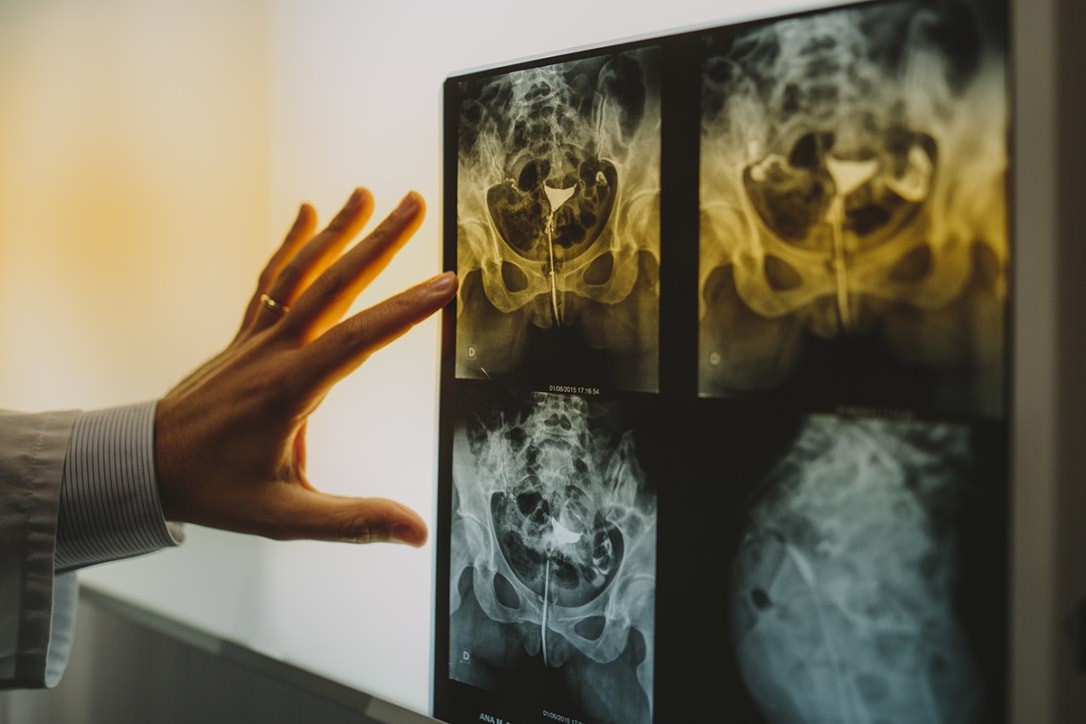
Hysterosalpingography: preparation and usefulness of the examination
Hysterosalpingography is an X-ray examination of the uterus and salpinges obtained by inserting – via catheter – a liquid (contrast medium) into the uterine cavity, which causes opacification
The liquid makes it possible to obtain X-rays with a “cast” image of
- uterus: cervical canal, isthmus, uterine cavity
- uterine tubes (salpinges) up to the abdominal ostium (end of the tube that opens into the peritoneal cavity that receives the oocyte at the time of ovulation).
What does a hysterosalpingogram investigate?
It is aimed at examining the morphological aspect of the uterus and tubes, with particular attention to their patency (i.e. their opening and the absence of conditions/pathologies blocking the passage, such as congenital malformations, inflammation or tumours).
It is a dynamic investigation because – through the acquisition of various images – it studies in real time the progress of the contrast agent through the uterine cavity and the different tubal portions up to the peritoneum.
Why have a hysterosalpingogram?
The examination is intended for women who suspect a pathology of the structures under investigation, particularly patients who need to investigate tubal patency, when – despite several attempts to become pregnant – pregnancy does not occur and there is a suspicion of infertility or sterility.
Hysterosalpingography: how do you prepare for the examination?
During the month in which the examination is carried out, pregnancy should not be sought; it is therefore advisable either not to have sexual intercourse or to have it protected by the use of a condom.
The evening before we recommend that you take a laxative or take an enema to empty your bowels, so that during the examination the visualisation of the uterus and surrounding structures is as clear as possible.
I need to have a hysterosalpingography and I am menstruating
In urgent situations, the examination can also be carried out during the cycle, however, it is recommended if possible to carry out the hysterosalpingogram between the fifth and thirteenth day of the cycle in the absence of blood loss.
How is a hysterosalpingography performed?
- the patient is in the gynaecological position (lying on her back with her legs spread and resting on the bed’s stirrups);
- the doctor inserts a cannula through the opening of the vagina;
- the cannula reaches the uterine cavity or cervix (i.e. the cervix; the lower portion of the uterus);
- about 10 ml of a liquid (the iodinated contrast medium) is injected through the cannula, at which stage you may feel a slight discomfort;
- The contrast medium causes a progressive opacification of the uterus and fallopian tubes (or salpingi) and, having reached the end of these, tends to spill into the peritoneal cavity;
- as the contrast medium expands, the doctor takes serial X-rays of the entire female reproductive system;
- the examination is completed.
The patient must be reassured because she does not have to do anything special, just wait a few minutes in the gynaecological position and ‘endure’ the slight discomfort of the catheter and contrast medium.
How long does the examination last?
About 20 minutes.
After a hysterosalpingography
Some patients after a hysterosalpingogram experience some side effects, such as:
- mild vaginal discharge;
- abdominal cramps (similar to menstrual pain);
- asthenia (tiredness);
- dizziness (especially if the patient is hypotensive and gets up quickly from a lying position);
- mild and transient spotting.
These symptoms disappear within a few minutes, otherwise seek medical advice.
Contrast medium used
The contrast medium used in this method is a radio-opaque, water-soluble substance, which is important as the tubes are in direct communication with the peritoneal cavity, which is capable of reabsorbing water-soluble substances.
A fat-soluble contrast agent can also be used.
All contrast media used are absolutely safe for your health.
Is hysterosalpingography a painful examination?
Generally, it is not considered a painful examination, but there is no doubt that the insertion of the catheter and contrast medium can be more or less uncomfortable depending on your level of tolerance.
Some report that the discomfort experienced is very similar to the pain associated with the menstrual cycle.
Our advice, however, is to stay calm and try to avoid anxiety as much as possible, which can only make the uncomfortable sensation worse.
As already mentioned, the examination only takes a few minutes.
Is hysterosalpingography a dangerous examination?
The examination is not dangerous and possible complications are very rare.
Since it is an examination that uses X-rays, it should not be performed too many times close together.
Antibiotic prophylaxis will be prescribed to avoid infectious complications.
Hysterosalpingography: what are the possible complications?
Among the most frequent possible complications is an allergic reaction to the contrast medium or the materials used in the test, which is, however, a rare occurrence.
More serious – but fortunately very rare – risks include uterine catheter lesions and pelvic infections.
Read Also:
Emergency Live Even More…Live: Download The New Free App Of Your Newspaper For IOS And Android
Endometriosis: Symptoms, Diagnosis And Treatment
Papilloma Virus Infection And Prevention
Fibromyoma: The Uterine Fibroma
Gynaecological Cancers: What To Know To Prevent Them
Total And Operative Hysterectomy: What They Are, What They Involve
Miscarriage: Causes, Diagnosis And Treatment
Vulvodynia: What Are The Symptoms And How To Treat It
What Is Vulvodynia? Symptoms, Diagnosis And Treatment: Talk To The Expert
Accumulation Of Fluid In The Peritoneal Cavity: Possible Causes And Symptoms Of Ascites
Accumulation Of Fluid In The Peritoneal Cavity: Possible Causes And Symptoms Of Ascites
What’s Causing Your Abdominal Pain And How To Treat It
Pelvic Varicocele: What It Is And How To Recognise The Symptoms
Can Endometriosis Cause Infertility?
Transvaginal Ultrasound: How It Works And Why It Is Important
Candida Albicans And Other Forms Of Vaginitis: Symptoms, Causes And Treatment
What Is Vulvovaginitis? Symptoms, Diagnosis And Treatment
Vaginal Infections: What Are The Symptoms?
Chlamydia: What Are The Symptoms And How To Treat It
Chlamydia, Symptoms And Prevention Of A Silent And Dangerous Infection


